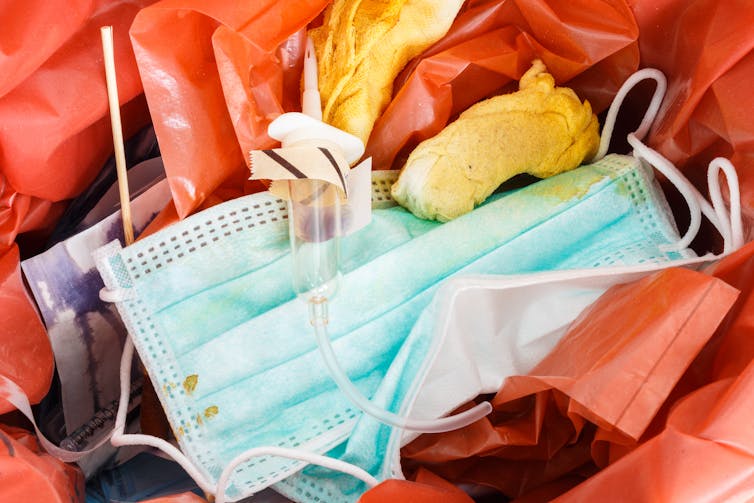The health impacts of environmental change are now squarely on the radar. Australia’s recent intense wildfires is one glaring example. Spillover of the virus causing the COVID-19 pandemic from animals to humans is another.
But less is known about the reverse: environmental harms from health care. This is what our study, the first global assessment of the environmental footprint of health care, aimed to do.
Read more: We must rethink health care to include social and environmental costs of treatment
We quantified resource consumption and pollution by the health-care sector in 189 countries, from 2000 to 2015. We found health care is harming the environment in ways that, in turn, harm health, thereby counteracting the primary mission of health care.
For example, we found the health-care sector causes a substantial share of the world’s emissions of greenhouse gases and air pollutants: 4.4% of greenhouse gases, 2.8% of harmful particulate matter (air particles), 3.4% of nitrogen oxides and 3.6% of sulphur dioxide.
A vicious cycle
As part of broader economic systems, the health-care sector can inadvertently harm health through purchased resources, and the waste and pollution produced. In other words, it can unwittingly harm health in efforts to protect and improve it.
The aim of our study was not to assign blame to health care. Rather, as our dependence on health care increases, we need to support this sector to become more sustainable so we don’t enter a vicious cycle, where more health care means more environmental damage, and vice versa.
Read more: What happens to waste PPE during the coronavirus pandemic?
Using a global supply-chain database, we measured direct and indirect environmental damage driven by health-care demand.
We focused on environmental stressors the health-care sector contributes to with known adverse feedback cycles for health, such as greenhouse gas emissions, particulate matter (10 micrometers or less in diameter) and scarce water use.
We found health care causes environmental impacts that range between 1% and 5% of total global impacts, depending on the indicator. It contributes to more than 5% for some indicators at the individual country level.
For example, along with its contributions to greenhouse gases and air pollutants, health care uses 1.5% of scarce water in the world. Scarce water is measured as water consumption weighted by a “scarcity index”, which takes into account insufficient access to clean water in different countries.

Polluting economies lead to polluting health care systems
For all stressors, countries with large populations, economies and health budgets (the US and China, for instance) dominate the results in absolute terms.
The key message is that we need to understand how these stressors are trending over time, and what measures can be taken to improve health and protect the environment at the same time.
For example, in South Korea emissions of greenhouse gases, sulphur dioxide, nitrogen oxides and particulate matter from health care decreased by between 27% and 60% during 2000 and 2015.
Whereas in China, sulphur dioxide, nitrogen oxides and particulate matter from health care increased by between 91% and 173% in the same period.
For some indicators such as greenhouse gas emissions and particulate matter, a majority of impacts are hidden in upstream supply chains. Unravelling supply chain connections will help us understand the hotspots of environmental impacts, such as pharmaceuticals and medical supplies.
A matter of ethics
The environmental impact of health care is both a practical and ethical issue for health-care professionals.
In 2015, more than 460,000 premature deaths were related to coal combustion globally. Frankly, why should any hospital purchase coal-fired energy when it produces toxic air pollution that harms health?
Some health professionals may baulk at this additional responsibility because they’re busy providing life-saving treatments and don’t have time to worry about the pollution they cause.
And some might say a global pandemic is not the time to burden health-care professionals with another responsibility.
We argue there’s no better time to raise this issue than when the eyes of the world are on health care. The pandemic has shown us we can achieve change at pace and scale if the evidence is clear and the collective will is shared.
The pandemic has brought attention to waste from single-use personal protective equipment. However, we are yet to develop consistent systems for monitoring these environmental impacts, and to implement effective strategies to reduce these impacts across the world.

The way forward
Health-care organisations at every level (national, regional, hospital, primary care) should measure and track their environmental footprint over time, as they do for health outcomes and financial costs.
All health-care professionals – from doctors and nurses, to managers and members of hospital boards – should understand the environmental footprint of the health care they provide and take steps to reduce it.
The purchasing power of health care should be harnessed to drive sustainability transitions in other sectors. For example, health-care organisations purchase large amounts of food for patients. The managers responsible for this food procurement should ensure the food is healthy, value for money and produced in sustainable ways.
Some health-care organisations are already making progress. Civil society organisations like Global Green and Healthy Hospitals are spreading the word. But there is an urgent need for all health organisations to step up.
As health professionals around the world increasingly call for action on climate change, it’s important to ensure their own house is in order.

